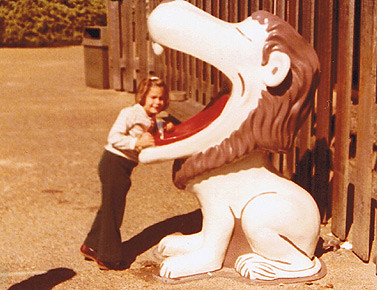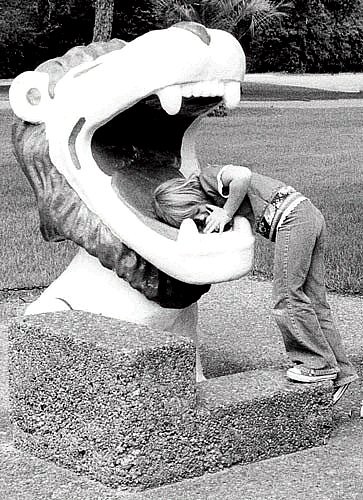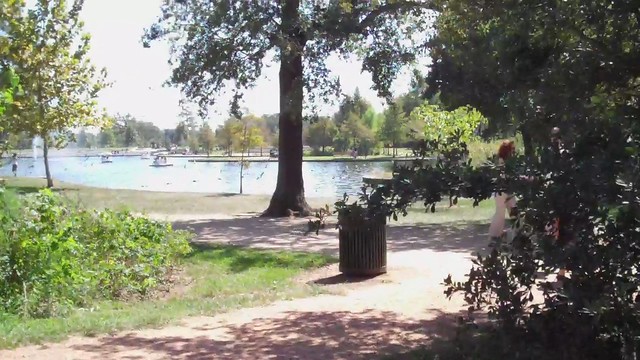General notes on Verse 1
- This verse is thought to be linked to Image 8 and a casque in Hermann Park in Houston, TX. To understand how that area has changed since 1981, visit our Hermann Park history page.
- The proposed solution for this casque is given on the Image 8 Verse 1 Solution page.
Interpretation
| Lines | Interpretation(s) |
| Fortress north
Cold as glass |
- "Glass" suggest that this is not a literal fort, but some other (modern) building. Most likely, it is just a general reference to downtown Houston and its many glass-covered skyscrapers.
- "Cold as glass" is a phrase in Ayn Rand's novel Anthem (published in 1938) and is used in that book to describe the steel rail of a subway train. If these words really are a reference to that book, they might be directing us to train track.
- "Cold as glass" is also a phrase in Wilma Dykeman's nonfiction book The French Broad (published in 1955) and is used there to describe a still body of water. If these words are a meant as a reference to that, they might be directing us to a lake.
- The Glassell School of Art in Houston was built in 1979 and used glass tiles to insulate the building and keep it cool.
|
| Friendship south |
- Houston's Hermann Park has a Taipei Friendship Pavilion that was a bicentennial gift from the City of Taipei to the City of Houston in 1976. As part of the redesign of that park, the pavilion was relocated to a new position in 2013/14.
- A YouTube video about the Houston pavilion shows detailed images and gives a little more history. In particular, it shows the original location before the move (at 0:13 and again at 6:38).
- Apparently Taipei gave two identical pavilions to U.S. cities in 1976. Intriguingly, the other pavilion, in San Francisco's Golden Gate Park, is now the focus of the search for the Image 1 / Verse 7 casque.
|
|
Take your task To the number Nine eight two |
- An antique Southern Pacific steam engine numbered "982" was on display in Houston's Hermann Park for half a century, and these lines of the verse are almost certainly a reference to that. The engine was moved around a few times before it left the park in 2007, but we know that in 1981 it was located at the southeast corner of the lake. (For full details on how we reconstructed the locomotive's location, see the Hermann Park history page.)
|
|
This map shows the steps so far:
|
|
| Through the wood
No lion fears |
- These are arguably the most important lines in the verse, because they tell us which way to go around the lake. Going clockwise (as viewed from above) would take us west, past the entrance to the zoo, which would make sense with a reference to lions. Going counter-clockwise would take us north through a forested area, which would make sense with the reference to "a wood." Either direction would take us to a place with tracks for the miniature train.
- "The wood no lion fears" might be a reference to the cowardly lion making it through the Haunted Forest in The Wizard of Oz, but it isn't clear how that reference would indicate a direction.
- The Houston Zoo had at least one water fountain shaped like a lion, but it isn't clear whether one would have been visible from outside the zoo. (Both of the pictures below are apparently from the Houston Zoo in the 1970's. Either the fountain got moved around, or there were multiple fountains.) 
|
| In the sky the water veers |
- This probably refers to a fountain that shoots water in the air. In 1981 there was one on the western side of McGovern Lake in Hermann Park. It probably would have been visible from anywhere on the perimeter of the lake.
|
| Small of scale Step across |
- This line is one of the most direct and useful clues in the whole book. "Small of scale" refers to something that has been miniaturized but has kept the same proportions (the same scale) so it looks realistic. And, as any train enthusiast knows, smaller versions of trains have a variety of modelling scales to maintain the appearance of a full-size train. Hermann Park has one such miniature railroad.
- If the line said "step over" or "step onto," it could refer to the train itself or to any small model. But the word "across" generally refers to something that stretches out for a distance on either side, like a river or a street. And the phrase "step across" means that whatever we are crossing is no wider than a single step. When combined with the line above, about "small of scale," there can really be no doubt: This line is clearly telling us to step across the tracks for the Hermann Park miniature train.
- If Preiss were giving us directions to go from the zoo to the Atropos Key or the Miller Outdoor Theatre or the Pioneer Memorial Obelisk, there is no way he would phrase the directions like this. Going to any of those destinations would mean either crossing the railroad tracks twice or not crossing them at all. But the verse very clearly tells us once (and only once) to "step across."
- The power of this clue is that it substantially narrows the search area. The current train route goes all around Hermann Park, but the route in 1981 was much shorter and was restricted to the northwest, north, and east shores of McGovern Lake. (See map below.) If we are only told to cross the tracks once, our destination must be somewhere within that 1981 loop.
|
| Perspective should not be lost |
- One of the distinctive things about Image 8 is that it's the only painting in the whole book to use one-point perspective, where lines that would be parallel in real life converge to a vanishing point in the distance. (The other 11 paintings are all essentially flat and don't show any depth or distance.)
- This line might be telling us to stand in a place where we can see a similar effect. If so, this is a very powerful clue. The interior of the 1981 train route consisted mostly of open woodlands and there were very few places where one could see parallel, straight lines. Our options for where to stand are narrowed down to only a few spots.
- This line could also mean that we need to move into a place where we see columns or other objects positioned in the same perspective as in Image 8. The two most likely features would be the two mentioned here in the verse: the steam locomotive ("number nine eight two") and the fountain in McGovern Lake ("the spout"). Perhaps not coincidentally, those two features appear to be shown overlapping in the image. The whirlwind around the genie resembles a fountain, but it casts a shadow resembling the smokestack of a steam locomotive.
|
|
In the center of four alike Small, split, Three winged and slight |
- This is possibly a reference to a group of four elm trees. Observers have reported that Hermann Park contains a group of four elm trees, three of which are winged elms. It isn't clear, however, whether the trees were present in the park in 1981. Current views of the wooded areas near the obelisk appear to show mostly pines and cypresses.
- The reflection pool at the park used to contain four small fountains, as shown here.
|
| What we take to be Our strongest tower of delight Falls gently In December night |
- This is a modification of a sentence from Pierre; or, The Ambiguities, written by Herman Melville in 1852. The original sentence is "What we take to be our strongest tower of delight, only stands at the caprice of the minutest event — the falling of a leaf, the hearing of a voice, or the receipt of one little bit of paper scratched over with a few small characters by a sharpened feather." This might tell us that we should be standing in a grove of deciduous trees that lose their leaves in December.
- The use of a Herman Melville quote here appears to be a hint to steer readers to Hermann Park. (For more information on the Melville connection, see further down this page.)
|
| Looking back from treasure ground There's the spout! A whistle sounds. |
- The final lines might describe what one can see and hear from the treasure spot.
- Given the connection between this verse and Herman Melville, a phrase like "there's the spout" has a strong, intuitive connection to the shouts made by whalers when they spotted a whale (e.g., "thar she blows!").
- The "whistle" could refer to the whistle on the park's miniature train.
- These final lines of the verse strongly suggest that when we are standing in the right spot we should be able to look "back" (toward Engine 982) and see a spout of water while also hearing a train whistle blow.
|
Taken all together, it seems clear that Verse 1 is giving us a very direct formula for finding the "treasure ground":
The proposed solution for this casque is given on the Image 8 Verse 1 Solution page.
|
|
The Herman Melville Connection
Two parts of the verse appear to directly reference works by Herman Melville. First, there is the almost direct quotation from Pierre; or, The Ambiguities:
|
The Secret (Verse 1) |
Pierre; or, The Ambiguities (Book IV, Chapter II) |
| "What we take to be Our strongest tower of delight Falls gently In December night" |
"But is life, indeed, a thing for all infidel levities, and we, its misdeemed beneficiaries, so utterly fools and infatuate, that what we take to be our strongest tower of delight, only stands at the caprice of the minutest event—the falling of a leaf, the hearing of a voice, or the receipt of one little bit of paper scratched over with a few small characters by a sharpened feather? Are we so entirely insecure, that that casket, wherein we have placed our holiest and most final joy, and which we have secured by a lock of infinite deftness; can that casket be picked and desecrated at the merest stranger's touch, when we think that we alone hold the only and chosen key?" |
It's worth noting that the passage referenced in Pierre is about putting something of value into a casket that can then "be picked and desecrated at the merest stranger's touch." Byron Preiss must have thought of those words several times as he buried his casques in various public places, never knowing if a stranger might dig up the box the very next day.
But Pierre; or, The Ambiguities is a very, very obscure work and Preiss must have known that — in the pre-internet era — it would have been very unlikely that anyone would have recognized the quote. So Preiss also included a reference to Melville's most famous work, Moby Dick. The entire plot of that novel is about whalers searching for a specific whale of great value. The deranged Captain Ahab has promised a piece of gold to the first sailor to spot that white whale. But the only way to spot a whale from a distance in those days was to watch for its spout — the plume of water and air that a whale blasts out of its blowhole when it comes to the surface. So the entire book becomes a search for the spout or fountain associated with the treasure. In fact, the word "spout" appears (in one form or another) over 100 times in Moby Dick and there is an entire chapter devoted to just the mechanics of how and when a whale spouts. And the title of that chapter (#85) is... The Fountain!
In Hermann Park in Houston there was (in 1981) a lake with a fountain. But the fountain wasn't anything fancy. It existed only to oxygenate the water so that the fish wouldn't die, and it consisted of only a single spout of water going straight up, mixing with air, and coming back down. In other words, it was essentially identical to the spout of a whale. In Verse 1 Preiss is taking us on a walk that starts at Engine 982 and ends at the treasure ground. And the closing lines of the verse tell us that when we look back at the locomotive from the treasure spot we should see the spout of a whale. In other words, we need to be on the far side of the lake.
Hermann Park
The map below shows the lake area in Hermann Park as it was in 1981. The round building directly south of the lake is the Visitor Services building of the Houston Zoo. Steam Engine 982 is the black rectangle just east of that, pointing to the west. Miller Outdoor Theater is the purple shape just barely visible in the upper right corner. The Atropos Key is at the top of the hill just north of that. If the "small of scale / step across" lines refer to the tracks of the miniature train, then our destination must be somewhere within the gray line showing the train's 1981 route. And the fountain is the dark blue dot in the lake. If we are in the right "treasure ground," we should see the whale-spout-fountain when we are looking across the lake to Engine 982.

Below is an aerial view of McGovern Lake in 2015. The Pioneer Memorial Obelisk has been moved 50 feet south to the middle of the path. The area between the obelisk and the lake has been developed into a lawn for picnicking. Engine 982 and the fountain on the west side of the lake are both gone. The edge of the lake has been reshaped and a boat rental place has been added. New paths have been added and the tree canopy has been thinned. Most significantly, new paths, island, and waterways have been added on the western edge of the lake. (For a more complete description of how this area has changed since 1981, visit our Hermann Park history page.)

Here's a 2010 video that shows the view from the miniature train as it travels eastwards over the bridge and passes south of the obelisk. (Click on photo to connect to video.)
Hints from Byron Preiss:
Before he died in 2005, the publisher of The Secret had two significant e-mail exchanges with a member of the Q4T website who goes by the username of "wilhouse." The first e-mail explicitly confirmed that there was a casque in Houston. The second e-mail was more cryptic about whether the casque was buried at Hermann Park. Both e-mail messages are reproduced in their entirety below. (For the sake of clarity, the words written by Preiss are shown in bold, blue text. The snippets he included from each original e-mail from wilhouse are inside the < and > brackets.)
-
Email 1
----- Original Message -----
Subject: Re: verse 1 the secret
Date: Tue, 18 May 2004 12:58:49 EDT
In a message dated 5/18/04 12:06:52 PM, wilhouse writes:
<thx wilhouse>
there is a treasure in houston. that's all i can tell you.
-
Email 2
----- Original Message -----
Subject: Re: A final plea before it's too lateDate: Thu, 7 Jul 2005 10:24:32 EDT
it might be there...it would not be a waste of time to dig there, but I cannot make any guarantees whatsoever
<in the children's zoo, it will be destroyed and I will be heartbroken.
Can you at least confirm whether I am in the right location or not? We found the original article on the casque found in chicago and noticed that you did originally advise the Chicago finders that they were right. If I am in the wrong location, then the clues to the casque are gone and the hunt is over anyways. Any information that you would be willing to give up would be greatly appreciated.
regards,
wilhouse>
Other Notes:
- The three things that have kept this search focused on Hermann Park are 1) the reference to "Nine eight two" (meaning the locomotive), 2) the words "Small of scale" (meaning the small-scale railroad), and 3) the quotation from a work by Herman Melville (as a hint at "Hermann").
- The Houston Chronicle has an article online about the move of locomotive 982 from Hermann Park to Minute Maid Park in 2007.
- For historical photographs of the Houston area, check out the University of Houston Digital Library.



